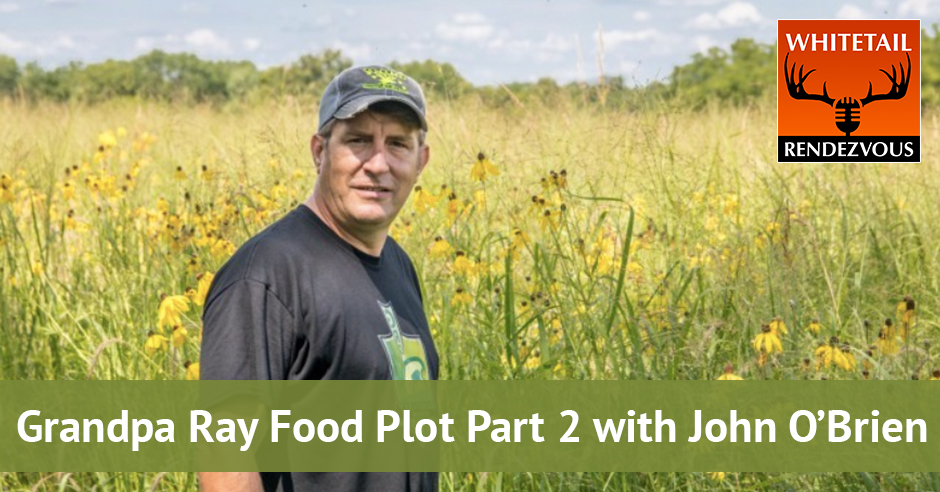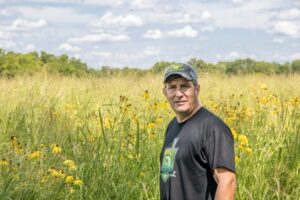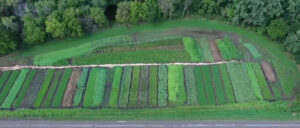
There’s such a great feeling when you get something done right the first time. Most often though, we get so excited that even when we get the plans in place and get right to work, we tend to forget one component. With making food plots, however, one such thing that we should never overlook is the soil test. John O’Brien of Grandpa Ray Outdoors is back for this second segment to talk about doing the soil test and why you need to do it right the first time.
—
Listen to the podcast here:
Grandpa Ray Food Plot Part 2 with John O’Brien
It’s the second segment with John O’Brion of Grandpa Ray Outdoors. John and I are talking about “do it right the first time.” What happens to us all and I’m guilty as anybody, I get all excited. We get the plan in place. We go to work and we forget something, we forget one component. It could be any number of the components. The first thing that we never want to forget is to do the soil test. After that, it becomes a slippery slope sometimes. Others, you could build a food plot in downtown Manhattan without water, without dirt and it would still grow. There’s dirt in the street anyway so it’s got that, but most of it, it’s a struggle. Why do we need to do it right the first time, John?
When I talk to people that either is brand new or even for those who are experienced, I ask a lot of questions. The more questions I ask, the better I can give recommendations. The problem that we see so often is we get guys that are like, “My buddy didn’t take a soil test and he had a great food plot this year.” He might have a great food plot next year, but if you don’t fertilize right, you don’t maintain your pH, eventually, it could be two years or five years. At some point in time, your soil will be mined and you could have a total failure. You have a year with a total failure. You spent money on the rifle, the shells and all these inputs and all of a sudden there’s no deer on your property because you don’t have an effective growing food plot.
We want a plan that’s not short-term. Many people want to buy that mix that their buddy told you to buy, the celebrity, the hunting show or whatever reason. It might be a great mix on your buddy’s land, but it might be a terrible thing to plant on yours. Every situation is different. Whether you ask me to help you and I ask you questions and you answer them, to give you some time to think and reflect or even you don’t get ahold of a guy like me. Put on paper your goals. What are you trying to accomplish? How are you going to get there? What are your current strengths? What do you think your weakness is? Let’s improve our strengths and let’s do way better on these weaknesses. Formulate a plan before hard-charging and get ground cover, get something to grow. It could be good this year, it could be a total failure. It’s like sighting in that rifle, “Do you want to go hunting?” “Sure.” Do you sight in your gun? You better. It’s the same thing. We want to sight in our food plots to not have average, to reduce our risk and to be as effective as we can. That’s what I want people to think about.
By planning, stage one, stage two, stage three in your land management plan for your food plots, that’s the stages that you plan out. You plan rotation in your crops as a farmer does. He doesn’t plant corn two years in a row unless he’s using a lot of supplemental fertilizers and stuff to replace the nutrients that are sucked out of the soil. You have to do the same thing, plus your deer changes. You’ve got to see what happens. If your neighbors change things up, you better know exactly what impact that is going to have on your deer.
The more I get into this, people say, “It sounds like work.” It is. You become a student. If the people do it right, it’s not working because they get some nice bucks. They get some nice does. They get a healthy deer herd on their property year after year. That’s what my goal is on the farm that I hunt. Every year, we have good deer. Are we going to have monster bucks? No, we might never have monster bucks. We’re going to have good bucks, mature bucks, three and half, four and half-year-old bucks through a process and it’s a learning process. What about equipment, John? When they go out and a brilliant manufacturer wants X for new connection to your ATV. Forget about tractors, you can do almost everything with an ATV as we see now. John, help me out here. Besides the seed, what else do we need?
Put your goals on paper and formulate a plan before hard-charging and getting ground cover. Share on XThe industry and certain companies might not love me to say this, but people tend to rush to buy equipment. They tend to overspend on equipment for their own situation. If you’re going to spend $10,000 on a fancy no-till planter. I’m not going to mention any names of any companies out there, but one that could plant your brassicas, plant your clovers or plant your soybeans. The guy has got five acres of food plots you’re planting. Step back, think about this rationally. Do you need to have that equipment? What does it cost you? What’s your real dollar for spending that money?
Let’s look at his long-term investment. Let’s say that equipment I’m buying is going to last us ten years, better not figure 20 or 30, typically it’s seven to ten-year depreciation. You spend $10,000 on that piece of equipment, if it lasts ten years, that’s $1,000 a year. They got five acres of food plots, that’s $200 an acre. Would you be better to have a professional come in and plant it? Do you need that equipment on two acres or five acres? I throw that at people. There are people that maybe somebody like Bruce there, maybe you’ve got so much money that it doesn’t matter to you. You want to have your fancy piece of equipment that you can show off to your cousin, Vinnie. You can go out there and plant, it doesn’t matter.
I got a plot master. I also got the average guy that’s not planting many acres. You could have a $100 spring to it. You could have a lawn roller. You could have a bag seeder and accomplish most of what you ever need to do on your land. Why do I bring that up? When we look at our food plot pyramid, my best investment is a process. Do you want to invest in equipment? Is that the most efficient use of your budget or is it to have that soil amended, to have the soil healthy? Yes. What’s the next best use of your money? Let’s get the right mix planted at the right time for your own situation.
Here’s a little story. I know I might be rambling a little bit. One of the biggest mistakes that I’ve seen out there for crop failure is not the quality of the seed. It’s planting depth. A guy I know bought a brand new gallon of X, Y, Z, state-of-the-art seeder. He gets ahold of me. He planted for a bunch of acres. The things aren’t growing well. We know it’s not the seed. We know what the germ count is. He had 90% germ-count seed that’s tested, it’s 90%. If you have an almost total failure, it’s not the seed. The tests don’t lie. If you plant seed that’s supposed to be 1/8-inch, 1/4-inch deep, and you bury it, you put an inch and a half deep because you don’t understand how to calibrate your equipment, we got failure. The deer might be on your neighbors.
 Input, if you’re brand new, let’s start with an inexpensive equipment. Learn about how to plant, planting depth, the timing of it and all these little basic management tools in the areas. After maybe two or three years, let’s start investing in equipment once you get all the other stuff mattered. That’s what I want people to do. That’s how I want you to think. Many people got a budget. Many people spent way more than they thought that land was going to cost. Maybe you can’t afford that fancy piece of equipment. Do you even need that fancy piece of equipment? Ask yourself, evaluate. Do you need it? Maybe or maybe not.
Input, if you’re brand new, let’s start with an inexpensive equipment. Learn about how to plant, planting depth, the timing of it and all these little basic management tools in the areas. After maybe two or three years, let’s start investing in equipment once you get all the other stuff mattered. That’s what I want people to do. That’s how I want you to think. Many people got a budget. Many people spent way more than they thought that land was going to cost. Maybe you can’t afford that fancy piece of equipment. Do you even need that fancy piece of equipment? Ask yourself, evaluate. Do you need it? Maybe or maybe not.
On YouTube, they’re going through some changes. Planning a food plot on a $100 of equipment, cinder block, bedsprings or heavy gauged baseball fences, the whirlybirds and lawn compactor, the thing that rolls around to put water in, close up the soil or compact the soil, the thing that you go out and check because it’s an exciting thing. I’ll grant you 100% people that do the work, you sweat, have some laughs, drink beer and get bit by the mosquitoes. All of a sudden come June, July, there’s some green stuff coming up.
By August, the deer have found your green stuff and now they’re mowing it for you. If you’ve done everything right, it carries through to the hunting season and you’ve created something. That’s a great feeling. Talking to a lot of guys and gals, that’s one of the best feelings about food plots. I did that and they never had done that before. I know people come up to John and say, “Look at the pictures of my food plot. Look what I have done.” You’ll accomplish something. Everybody’s cheering you on and so as the deer because they’re happy. Your thoughts, John?
I look at it as a holistic long-term experience. There are people now that I’ve been working with that are passionate about food plotting. That’s what happens. You started hearing people say, “I love feeding deer. It isn’t about harvesting that deer, whether it be a buck or doe or whatever. For some people, they’re like me. I shot a decent buck, but it’s not about that. It’s like the fruits of our labor. We can see healthy deer. Everybody talks about that big buck. Why is that buck healthy? Because three years ago you were doing a lot of things right.
Two years ago, your program, you’re doing things right. It isn’t an instant thing. You don’t put a plot out in the fall and all of a sudden an average buck becomes a huge buck. When you’re sitting there and you’re looking at nature, some of these mixed, especially some of the things that were coming up with now, especially if your wife and your kids would get more into it. They’re seeing certain species that look more attractive, not for deer. You’ve created bedding and habitat areas with pollinators. It takes the most standing pitchers.
Instead of the being about that moment where you pull the trigger, it’s both the moment that maybe you’re out there observing, you’re scouting them a month before the season, sitting there overlooking all these beautiful things. Another area, maybe you’ve got the steep slope, maybe your soil has been eroding and you’re becoming a conservationist. You’re being a good landscaper. You’re laying the foundation for your kids and their kids. I have a property that is driving beyond when you and I are gone. That’s what it’s about. It isn’t in both of them now. It’s both the now and the later.
Your best investment is the process, not the equipment. Share on XThe guy that shared to me said, “Before you start any endeavor, do the old Ben Franklin thing.” Franklin took a piece of yellow paper, white paper and draw a line down the middle. You put pros and cons, yes or no, dollars and cents or however you want to balance it out. You go, “Here are all the reasons I should do it right and here are what’s going to happen if I don’t do it right. At the end of the day, staring in your face is your answer. A lot of people look at it, “I’m going to do it anyway.” At least you’ve done some due diligence and you figured it out. People who don’t hunt don’t have a clue what we’re talking about here because maybe in nine hours of talk, we’ve got less than a minute about shooting deer, killing deer, harvesting deer and eating deer. All the rest is putting into our ground, developing our ground, developing our herd and being a conservationist. People think about this, the next time you have a conversation with somebody that, “I don’t know why I hunt.” Let me tell you why. It’s conservation. I’m helping with soil erosion. I’m helping with wind erosion. I’m helping with pollination. I’m helping do all these things. That doesn’t sound like hunting. It is. John, any final thoughts on doing it right the first time?
That’s my biggest thing I’m pointing out whenever I hammer home with people. I love your idea. That’s what I’ve been doing a few seminars, write down the pro and the con. Every action has a reaction. Everything in life, soil nutrition, there’s a positive charge and a negative charge, yin and yang. There are two ways to look at things. There are many potential outcomes. The way I’m out to be educated about what you do, whatever your decision is, to understand what may happen. That’s the way life is. There’s always a lot of unknowns. My point is to reduce the unknowns. Let’s try to have more knowns on your property.
 How do people get in touch with Grandpa Ray Outdoors?
How do people get in touch with Grandpa Ray Outdoors?
Call me at (608) 235-0628 Monday through Friday, 8:00 AM to 5:00 PM Central Standard Time. You can email me at OBrionAg@Gmail.com.
With that, we’re going finish up with Grandpa Ray Outdoors, presents expectations.
